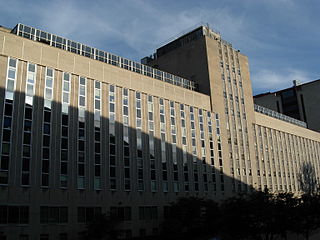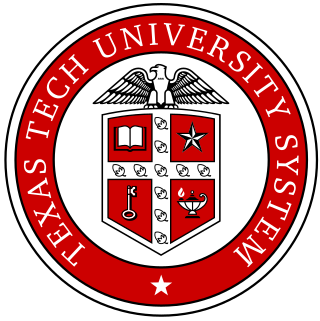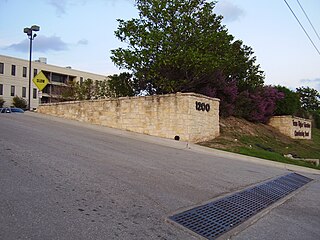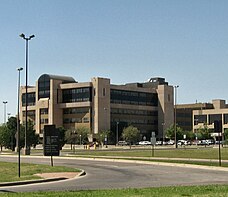
The Albert Einstein College of Medicine is a private, nonprofit, research-intensive medical school in the Morris Park neighborhood of the Bronx, New York City, United States. Founded in 1953, Einstein operates as an independent degree-granting institution as part of the integrated health care Montefiore Health System and also has affiliation with Jacobi Medical Center.
The University of Texas Southwestern Medical Center is a public academic health science center in Dallas, Texas. With approximately 23,000 employees, more than 3,000 full-time faculty, and nearly 4 million outpatient visits per year, UT Southwestern is the largest medical school in the University of Texas System and state of Texas.
The Virginia–Maryland College of Veterinary Medicine is a state-supported college of two states, Virginia and Maryland, filling the need for veterinary medicine education in both states. Students from both states are considered "in-state" students for admissions purposes.
The University of North Texas Health Science Center is a public academic health science center in Fort Worth, Texas. It is part of the University of North Texas System and was founded in 1966 as the Texas College of Osteopathic Medicine, with its first cohort admitted in 1970. UNT Health Science Center consists of six schools with a total enrollment of 2,329 students (2020–21).

The Texas Tech University Health Sciences Center (TTUHSC) is a public medical school based in Lubbock, Texas, with additional campuses in Abilene, Amarillo, Dallas, and the Permian Basin. TTUHSC serves more than 100 counties in the western portion of Texas. The university is a separate institution from Texas Tech University; both universities are among five universities that are part of the Texas Tech University System. Texas Tech University Health Sciences Center El Paso, founded in 1969 as a branch campus of TTUHSC, became a separate institution in 2013.


The University of Missouri–Kansas City School of Medicine, established 1971, is one of three medical schools located near downtown Kansas City. The school offers an accelerated combined Bachelor/MD program based on a six-year curriculum. The school of medicine admits students into the program directly from high school and within six years the graduates attain an undergraduate and a doctor of medicine degree (BA/MD) from UMKC. The curriculum integrates the liberal arts, basic sciences, and clinical sciences with a team approach to learning. More than 2,000 physicians have graduated from the UMKC–SOM six-year combined degree program. The program is extremely competitive. For the 2015-2016 application cycle, at least 40% of all successful out of state applicants received admissions prep.

The Texas Tech University System is a state university system in Texas consisting of five universities in the state of Texas, of which three are general-academic universities, Texas Tech University, Angelo State University and Midwestern State University, and two health-related institutions, Texas Tech University Health Sciences Center and Texas Tech University Health Sciences Center El Paso. Headquartered in Lubbock, Texas, the Texas Tech University System is a $2.5 billion enterprise focused on advancing higher education, health care, research and outreach with approximately 21,000 employees, more than 63,000 students, nearly 370,000 alumni and an endowment valued at $1.7 billion. In its short history, the TTU System has grown tremendously and is nationally acclaimed, operating at 24 academic locations statewide and internationally.

Texas Tech University Health Sciences Center El Paso is a public university focused on the health sciences and located in El Paso, Texas. It was founded in 1969 as a branch campus of the Texas Tech University Health Sciences Center and became a separate institution in 2013.

Texas A&M University School of Medicine is the medical school at Texas A&M University and a component of Texas A&M Health. The School offers M.D., M.D./Ph.D., M.D./M.P.H, M.D./M.B.A., M.D./M.Eng., and several other M.D./M.S. dual degree programs.

Texas has over 1,000 public school districts—all but one of the school districts in Texas are independent, separate from any form of municipal or county government. School districts may cross city and county boundaries. Independent school districts have the power to tax their residents and to assert eminent domain over privately owned property. The Texas Education Agency (TEA) oversees these districts, providing supplemental funding, but its jurisdiction is limited mostly to intervening in poorly performing districts.

The University of New Mexico School of Medicine is a division of the University of New Mexico Health Sciences Center located in Albuquerque, New Mexico. The UNM School of Medicine is home to a variety of degree-granting programs, including the only MD program in the state.
Medical school in the United States is a graduate program with the purpose of educating physicians in the undifferentiated field of medicine. Such schools provide a major part of the medical education in the United States. Most medical schools in the US confer upon graduates a Doctor of Medicine (MD) degree, while some confer a Doctor of Osteopathic Medicine (DO) degree. Most schools follow a similar pattern of education, with two years of classroom and laboratory based education, followed by two years of clinical rotations in a teaching hospital where students see patients in a variety of specialties. After completion, graduates must complete a residency before becoming licensed to practice medicine.
The Robert Larner College of Medicine is the medical school of the University of Vermont, a public research university in Burlington, Vermont. Established in 1822, it is the nation's seventh oldest medical school. The primary teaching hospital for the Larner College of Medicine is the UVM Medical Center in Burlington.

The Paul L. Foster School of Medicine is a medical school in El Paso, Texas at Texas Tech University Health Sciences Center El Paso. The Paul L. Foster School of Medicine is the 9th medical school in the state of Texas, and the medical school is the first one to open in almost four decades. As a result of the numerous financial donations, as well as state funds, The Paul L. Foster School of Medicine has the ability to expand, construct new buildings and hospitals, purchase elaborate training equipment, and hire nationally respected professors. This academic staff is able to train current students through the utilization of state of the art educational and skill enhancing technologies that are considered to be pioneering the medical education process for the next several decades. An example of this ability is demonstrated through the advanced technologies employed in their large Clinical Simulation Center.

Gábor Béla Rácz, is a Hungarian-American board-certified anesthesiologist and professor emeritus at Texas Tech University Health Science Center (TTUHSC) in Lubbock, Texas, where he is also Chairman Emeritus of the Department of Anesthesiology and Co-Director of Pain Services. He has worked in the field of chronic back pain and complex regional pain syndrome (CRPS).

The Virginia Tech Carilion School of Medicine is a public medical school of Virginia Tech and located in Roanoke, Virginia. The medical school is associated with the Fralin Biomedical Research Institute. Formed as a public–private partnership with the Carilion Clinic, the medical school grants the Doctor of Medicine (M.D.) degree to its graduates. Initially a private institution from 2008-2018, the medical school became an official college of Virginia Tech in 2018.
John Charles Baldwin was an American cardiac surgeon and academic administrator. He served as the surgery department chairman at Baylor College of Medicine, as dean of Dartmouth College's Geisel School of Medicine, as president and CEO of the Harvard Immune Disease Institute, and as president of the Texas Tech University Health Sciences Center.
Tedd L. Mitchell is the fifth and current Chancellor of Texas Tech University System, a $2.5 billion state university system with an annual enrollment of approximately 63,000 students across five separate universities - Texas Tech University, Texas Tech University Health Sciences Center, Angelo State University, Texas Tech University Health Sciences Center El Paso and Midwestern State University - and located on 24 academic locations statewide and international. A doctor of medicine, Mitchell is also a published author and chairman for the Board of Trustees for the Cooper Institute., a Dallas-based health and wellness system founded by Dr. Kenneth H. Cooper













